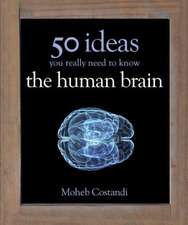Handbook of Lithium Therapy
Editat de FN JOHNSONen Limba Engleză Paperback – 20 apr 2014
Preț: 725.79 lei
Preț vechi: 763.99 lei
-5% Nou
Puncte Express: 1089
Preț estimativ în valută:
138.89€ • 144.19$ • 115.82£
138.89€ • 144.19$ • 115.82£
Carte tipărită la comandă
Livrare economică 22 martie-05 aprilie
Preluare comenzi: 021 569.72.76
Specificații
ISBN-13: 9789401171991
ISBN-10: 9401171998
Pagini: 480
Ilustrații: XXIII, 453 p.
Dimensiuni: 155 x 235 x 25 mm
Greutate: 0.67 kg
Ediția:1980
Editura: SPRINGER NETHERLANDS
Colecția Springer
Locul publicării:Dordrecht, Netherlands
ISBN-10: 9401171998
Pagini: 480
Ilustrații: XXIII, 453 p.
Dimensiuni: 155 x 235 x 25 mm
Greutate: 0.67 kg
Ediția:1980
Editura: SPRINGER NETHERLANDS
Colecția Springer
Locul publicării:Dordrecht, Netherlands
Public țintă
ResearchCuprins
I Introduction.- 1 The place of lithium in biological psychiatry.- II The clinical uses of lithium.- 2 Lithium in the acute treatment of mania.- 3 Lithium in the acute treatment of depression.- 4 Lithium in the prophylactic treatment of recurrent affective disorders.- 5 Special cases of affective disorder and their treatment with lithium.- 6 Inappropriate use of lithium in the treatment of reactive depressive cycles.- 7 Lithium therapy in combination with other forms of treatment.- 8 The psychiatric uses of lithium outside manic-depressive illness.- 9 The range of non-psychiatric uses of lithium.- 10 The relative efficacies of lithium and alternative modes of treatment.- III Factors determining therapeutic outcome.- 11 Acceptance of lithium therapy by the patient.- 12 Rejection of lithium maintenance therapy by the patient.- 13 Recurrences of manic-depressive episodes during lithium treatment.- 14 Predicting lithium responders and non-responders: physiological indicators.- 15 Predicting lithium responders and non-responders: psychological indicators.- 16 Predicting lithium responders and non-responders: illness indicators.- 17 Predicting lithium responders and non-responders: familial indicators..- 18 Lithium non-responders and their treatment.- IV The routine of lithium therapy.- 19 The context of lithium therapy.- 20 Physiological functions monitored in association with lithium therapy.- 21 Monitoring lithium dose levels: estimation of lithium in blood.- 22 Monitoring lithium dose levels: clinical aspects of serum lithium estimation.- 23 Monitoring lithium dose levels: estimation of lithium in urine.- 24 Monitoring lithium dose levels: estimation of lithium in saliva.- 25 Atomic spectrometric methods and techniques for the determination of lithium in biological materials: fundamental principles and recent advances.- 26 Requirements of an ideal lithium preparation.- 27 The choice of an appropriate lithium preparation.- 28 Lithium preparations currently available.- 29 Minimum serum lithium levels for effective prophylaxis.- 30 Social and psychological supportive measures during lithium therapy.- 31 Terminating lithium treatment.- V Contra-indications, side-effects and toxicity.- 32 Absolute and relative contra-indications to lithium treatment.- 33 The pattern of lithium side-effects and toxic reactions in the course of lithium therapy.- 34 Neural and neuromuscular side-effects of lithium.- 35 Endocrine side-effects of lithium.- 36 Cardiovascular side-effects of lithium.- 37 Haematological side-effects of lithium.- 38 Renal side-effects of lithium.- 39 Electrolyte and water balance side-effects of lithium.- 40 Bone side-effects of lithium.- 41 Cutaneous side-effects of lithium.- 42 Social and psychological implications of lithium.- 43 Immunological side-effects of lithium.- 44 Side-effects: miscellaneous.- 45 The recognition and management of lithium intoxication.- VI Special groups of patients.- 46 Lithium treatment of children and adolescents.- 47 Lithium treatment of the elderly.- 48 Lithium treatment of women during pregnancy and in the post-delivery period.- VII Sources of information about lithium therapy.- 49 Searching the lithium literature.- 50 A survey of books about lithium.









